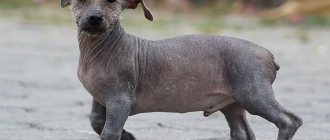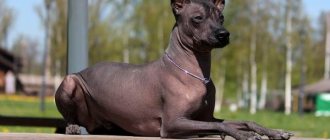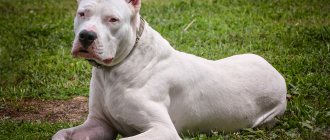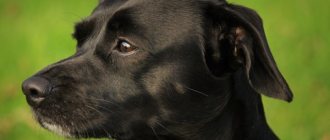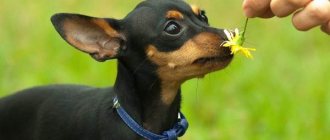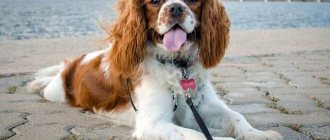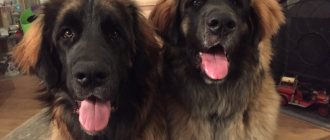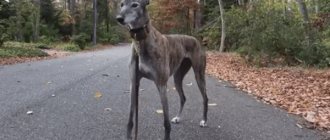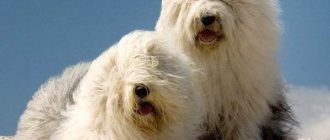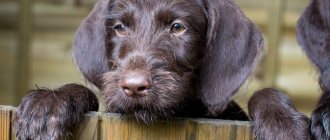History of the Xoloitzcuintle breed
Xoloitzcuintle
Mexican Hairless Dogs are unique in every way. They are considered among the lucky ones who have formed a separate breed due to a common genetic mutation - the absence of fur. In the case of the Xoloitzcuintle, this deviation was fixed for entire generations and became a distinctive feature. The animals turned out to be more adapted to the climate of Mexico than their counterparts. In addition, ticks, fleas and other parasites were not interested in dogs without hair and rarely bothered them with painful bites.
The extravagant appearance of the animals attracted the attention of the Aztecs. They also came up with the name “Xoloitzcuintle”. It came from the name of the god of the underworld - Xolotl (Xolotl), who controlled thunderstorms and accompanied the daylight. The deity was depicted as a humanoid monster with the head of a dog.
Xoloitzcuintles looked quite scary compared to other animals, so they were mistaken for the faithful companions of God and those who died on the way to Mictlan - the afterlife. According to Aztec mythology, the human soul encountered a number of obstacles that could not be overcome without a four-legged assistant. The central role of the breed is evidenced by archaeological finds - clay figurines and mummies of dogs. The oldest date back to the 5th millennium BC. e. Some figurines show imitation fur: they probably represent representatives of other breeds.
The Aztecs not only believed in the divine power of the xoloitzcuintli, but also strictly followed the instructions of the priests. When a warrior died, the inhabitants of the settlement performed a bloody ritual, which included the ceremonial killing of the deceased's dog. An arrow from its owner was placed into the animal's mouth. After this, the bodies were buried, and sometimes pre-mummified. Archaeological excavations in Mexico and the modern United States have revealed more than a dozen such “mass graves.”
Some finds suggest that the Xoloitzcuintle was kept for later consumption. Dog meat was considered a delicious dish, prepared only for important religious holidays. The Aztecs believed that this meal not only honored the gods, but also endowed ordinary people with the gift of seership. Representatives of the stronger sex ate the meat of hairless dogs, because they considered it the main aphrodisiac that strengthened male strength.
Xoloitzcuintle puppy
Xoloitzcuintles were also endowed with magical powers to heal ailments. This was largely due to the hot skin of the animals, which reduced discomfort due to its warming effect. The myth still “lives” in remote aboriginal villages, where xolos still “treat” rheumatism and other diseases.
The appearance of the conquistadors was a turning point in the history of the breed. The conquerors considered the New World their property and sought to impose cruel orders on the local inhabitants. The culture of the descendants of the Aztecs was the first to fall out of favor. The conquistadors demanded that the natives renounce ancient rituals that were contrary to civilized European religion. Xoloitzcuintles were ranked among the bright symbols of the outdated way of life and thereby signed their death warrant. Dogs were exterminated en masse, sometimes for food. By the end of the 16th century, the breed could hardly be called numerous. The animals managed to survive only in some remote mountain villages in Mexico.
Xoloitzcuintle named Pharaoh
The Xoloitzcuintli re-entered the world stage at the beginning of the 19th century - unfortunately, again as a raw material. Their skins were used to make leather items. The unenviable situation of hairless dogs changed only by 1850. Adherents of art, noticing the unusual appearance of the animals, did everything possible to stop their merciless exploitation. Dog enthusiasts organized mass expeditions to remote mountain villages, which had a fairly large population of Xoloitzcuintles. In 1887, the Xolo was officially recognized by the American Kennel Club (AKC). The first registered animal was a female named Mi Tu.
After this event, the breed was forgotten for a long time. Even the victory of the Xoloitzcuintle at the 1940 exhibition did not save the situation. Since Mexican Hairless dogs have fallen out of favor, the AKC has removed them from the breed registry. The number of Xoloitzcuintles decreased, and their owners attended dog shows less and less. The fate of the animals was again under threat, but there were lovers of this extravagant breed who sought to continue breeding work.
History knows only one name - Norman Pelham Wright. In 1954, he went looking for Xoloitzcuintles in remote Mexican settlements, mainly in the south of the state of Guerrero and in the Rio Balsas region. Norman Wright managed to purchase more than a dozen dogs from the Indians. While engaged in the selection of animals, the naturalist published the works “The Mystery of the Xolo,” where he described his charges in detail and formulated a preliminary standard for the breed. Wright’s work bore worthy results: in 1956, “Mexicans” were officially recognized in their historical homeland.
In 1986, the first hairless dog appeared in Russia, but the breed did not gain dizzying popularity. Meanwhile, clubs for Xoloitzcuintle lovers appeared in European countries, the USA and Mexico. Along with the addition of the breed standard, its participants called on dog breeders not to forget about the difficult fate of the Indian “natives” and no longer use them for personal gain. Educational activities turned out to be successful. Xolos have become the national treasure of Mexico, and their number in the world has exceeded 30 thousand individuals - record numbers for a breed that was twice on the verge of extinction.
In 2011, the AKC re-registered the Xoloitzcuintle. These animals are also notable for their accurate entry into the Guinness Book of Records, where they are recorded as the oldest breed of the same type and the owners of the highest body temperature.
Appearance of the Xoloitzcuintle
There are three types of Xolo:
- standard. Height at withers – 46-60 cm, body weight – from 9 to 14 kg;
- average. Height at withers – 36-45 cm; body weight – 6-10 kg;
- miniature. Height at withers – 25-35 cm; body weight – 4-8 kg.
Dog breeders believe that the ancestors of modern Xoloitzcuintle belonged to the first type. Animals with such proportions could easily survive in the wild, unlike their smaller counterparts. In addition, some medium and miniature hairless dogs tend to increase their size, which cannot be said about the standard Xoloitzcuintle variety.
The breed has a distinct sexual type: females look more graceful and light compared to males.
Head and skull
The Xolo is characterized by a high head carriage. Its size is proportional to the body. The type of skull is wolf: being quite elegant and at the same time strong, it tapers towards the nose. A small protrusion is visible in the back of the head. The frontal line is parallel to the animal's muzzle.
Muzzle
Has smooth outlines. The dog's under eyes are well filled in, but the cheeks remain flat. The stop is weakly expressed. The pigmentation of the nose depends on the base color. Xoloitzcuintles with dark skin have almost black skin. Golden yellow and bronze animals boast a coffee or flesh-colored nose. The nose of spotted dogs is notable for its partial pigmentation. The Xoloitzcuintle's lips are dry, do not create a rippling effect, and fit tightly to the jaws. Wrinkles are acceptable.
Ears
The high set of large and long ears of a hairless dog gives it a resemblance to a bat. In an excited state, the animal holds them almost at a right angle. The ears are soft and tender to the touch.
Eyes
The eyes of the Xoloitzcuintle are almond-shaped. The color of the iris varies depending on the base color. The most common options are yellow, amber, reddish brown, coffee or black. On dry and dense eyelids, a gray, brown or black edging is noticeable. The look is attentive and at the same time wary.
Jaws and teeth
The animal's strong jaws form a scissor bite. Having a complete dental formula is desirable, but not required. Completely hairless Xoloitzcuintles have weaker teeth than dogs with short, bristle-like hair. The latter examples are extremely rare.
Neck
When looking at a Xoloitzcuintle, a high, graceful neck is noticeable. It smoothly expands towards the base, turning into the line of the withers. The scruff is elegant and light. In adult dogs, the skin fits tightly to the throat, but in puppies, small folds are noticeable.
Xoloitzcuintle muzzle
Frame
The body of the breed is moderately stretched. Its length is 1.1 times the height of the animal at the withers. The relatively narrow chest drops to the level of the elbows. The ribs are not flattened. The back line is straight and short. Strong shoulder blades are set obliquely. The lower back is slightly convex in comparison with the back, and has more prominent muscles. The dog's croup is directed downward at an angle of 40°. The belly and groin are moderately tucked.
Tail
The tip of the Xoloitzcuintle's thin tail can be decorated with a small tassel. When lowered, it is slightly rounded. When moving, the animal raises its tail, but does not touch its back. Owners of hairless dogs note an interesting feature: when the Xoloitzcuintle gets cold, it tucks its tail between its legs. This same movement may also indicate fear (as in most of its relatives).
Forelegs
The forelegs appear dry and the joint angles are balanced. Elbows are pressed to the chest, directed strictly back. The forearms are straight, while the pasterns are set at a slight angle. The feet are hare-type, sometimes covered with short, coarse hairs. The color of the claws depends on the base color of the xoloitzcuintle. Dewclaws are removed in the first week after the puppy is born.
Hind limbs
The muscles are more pronounced in comparison with the forelimbs. The muscles are best visible on the animal's thighs. The angles of the articular joints are moderately expressed. The hock joints are directed parallel to the dog's body. Straight metatarsus set vertically. “Hare” feet are formed by arched toes that end in claws of a dark or light shade. The pads are elastic and hard. Removal of the fifth toes is mandatory within the first seven days after birth.
Movement style
The Xoloitzcuintle moves at a rapid trot, holding its head high and its back straight. With greater acceleration, the dog's paws shift towards the center of gravity, under the body. Strong hind legs provide the animal with a good push.
Coat
“Mexicans” are characterized by a complete absence of hair. Some dogs have a scruff and forehead decorated with coarse, sparse hair, reminiscent of a foal's mane. The length of the hairs does not exceed 2.5 cm.
Color
The color of the Xoloitzcuintle is monochromatic, mostly solid. Dark colors are desirable: gray, bluish-gray, gray-black and black. There are dogs with lighter colors: golden, bronze, liver or reddish. The presence of points is acceptable if they do not occupy more than ¼ of the surface of the animal’s body.
Possible defects
Xoloitzcuintle at an exhibition
The slightest non-compliance with the standard is considered a breed defect. Among the main ones, there is a slight deviation from the sexual type, excessively timid or excitable behavior, as well as beige or pink pigmentation of the eyelids.
The disqualifying faults of the Xoloitzcuintle are:
- a tuft on the top of the head (like a Chinese crested dog);
- loose skin forming numerous folds;
- hair on areas of the body not covered by the standard;
- short or completely docked tail;
- graceful and feminine proportions in males;
- excessive lack of melanin (albinism);
- aggressive or cowardly behavior;
- bulging round eyes;
- drooping or cropped ears;
- light pigmentation of the iris;
- undescended testicles into the scrotum;
- presence of dewclaws;
- pronounced dewlap;
- wide head format;
- undeveloped muscles;
- large size bitches;
- undershot or overshot;
- cat-shaped paws;
- lordosis or kyphosis;
- clubfoot.
Photo of Xoloitzcuintle
Breed standard
The following breeds are defined:
- in standard, medium sizes - guard dog;
- in miniature - a companion dog.
The withers should be less than the body length at 9:10. Males are shorter than females. Dogs of this breed have a faint bump on the back of the head. The head looks like a wolf's.
The skull is wide, strong, and at the same time graceful, tapering closer to the muzzle. In profile, the upper lines of the muzzle and skull are almost parallel. Dark-colored dogs should have a dark nose; Bronze colored dogs have a brown or pink nose.
The jaws are strong. The teeth are incisors that close tightly into a scissor-shaped bite. The eyes are almond-shaped, medium-sized, cheerful and observant. Eye color - black, brown, yellow-amber.
Dark eyes are more valuable. The ears are large and prominent. The guards are always raised. Dogs with ears that are cropped or not erect are not allowed. The neck is relatively high, thin, elegant, strong.
The physique is generally strong and muscular. The top line of the back is absolutely straight. The croup in profile is slightly convex and rounded. Short legs are not acceptable. The chest is long in profile and touches the bend of the elbow. The ribs are not flat, slightly protruding.
Broad chest in front, without protruding sternum. Strong belly. The tail is long and thin. When walking, it is raised fairly up, not twisted. When stationary, the tail hangs down, ending in a small curve.
Xoloitzcuintle age 2 years
When the tail is pressed between the legs, it is a sign of fear. The front legs are not short, straight, proportional, muscular, but graceful, which is noticeable with a beautiful, long, free step. The hind legs are straight, muscular, strong.
The toes are of medium length, located close to each other, and may even be overgrown with hair. It is advisable to remove the so-called fifth finger, a rudimentary process. Movement is confident, elegant, smooth.
Equally important attention is paid to the skin of dogs. It should be smooth, gentle, warm, pleasant to the touch. The skin must be especially carefully protected, because, due to the lack of hair, it is more susceptible to external influences and therefore more traumatic than that of “woolen” dogs.
And skin blemishes are punishable in the standards. The hair on the forehead and neck, which is present in small quantities, is not long and soft. Coarse hair covers the paws. The growth of these hairs is directed towards the tip of the tail. Dogs with long hair are disqualified.
Male Xoloitzcuintle
The color varies in the following shades:
- from black, black-gray, other variants of gray shades;
- brown with a red tint;
- bronze, golden yellow;
- may be spotted with white spots.
There are 3 sizes of dog growth:
- standard - 46-55 cm;
- average - 36-45cm;
- miniatures – 25-35 cm.
These sizes are standard for both male and female dogs. Animals whose size is outside the given limits will be disqualified. Disadvantages are any non-compliance with the standard.
This is an overly wide head, a fearful or vice versa, an angry animal, a color outside the given norms, or too large white areas of spots (albinism), the skin is not smooth, with dewlap, dark eyes are too small or convex, a short tail, legs, thin, long body, etc.
Dogs will be disqualified if:
- hair grows throughout the animal;
- ears droop or cropped;
- the incisors of the teeth are undershot or completely overshot;
- growth beyond regulatory standards;
- tail docked;
- a long, not stiff crest, in the image of the Chinese Crested.
Character of the Xoloitzcuintle
Mexican Hairless dogs have a balanced and friendly disposition with a spicy pinch of temperament. Although puppies are characterized by excessive playfulness, adult Xoloitzcuintles behave with dignity, as if they still proudly serve the Aztec deity. “Mexicans” make excellent companions - quiet, attentive and calm. Making friends with a dog is not difficult.
Curious friends
Like many of their relatives, Xoloitzcuintles are attached to the people with whom they live. In order for an animal to grow up sociable and loving, all family members must take part in its life - as they say, from young to old. At the same time, the dog will still single out one person, who will be considered the rightful owner.
If this happens to you, feel like an international lottery winner: it’s hard to find a more devoted friend! The Xoloitzcuintle will not retreat a single step so as not to miss a single event in the owner’s life. A dog can be intrusive, but you shouldn’t offend it by refusing the traditional portion of “cuddles.” For representatives of the breed, physical contact with the owner is very important, as is joint leisure time. If possible, take your pet with you when going anywhere. This will make your Xolo the happiest on the planet!
Representatives of the breed do not like the company of strangers and are extremely wary of them. Perhaps it was not for nothing that the Aztecs used the Xoloitzcuintle as a talisman against evil forces: these dogs are excellent watchdogs. Thanks to their developed hearing and sense of smell, “Mexicans” sense a stranger long before his appearance. The delicacy of Xolos is manifested even in their manner of warning the owner about unwanted guests: the animal will bark softly and begin to actively spin around at your feet, as if attracting attention. In case of danger, the dog will rush to attack without hesitation.
Xoloitzcuintle owners have different opinions about their pets' ability to get along with children. If you are looking for a friend for your child, it is better to pay attention to a golden retriever, corgi, Irish setter or giant schnauzer. Xolos are suitable for families with adult children who know how to handle dogs.
In the arms of the owner
Representatives of the breed easily find a common language with both their relatives and cats. Fights between females or males are quite rare, but can become a necessary measure when defending territory or self-defense. Adult Xoloitzcuintles show intolerance towards other people's dogs, so it is not recommended to let the animal off the leash if you are not confident in its ability to behave in four-legged company.
Mexican Hairless dogs are known for their athleticism and love for active walks. Every day you need to set aside at least an hour to jog with your pet in the city park. Bring your favorite Xolo toy with you: it will brighten up your time together. In clear weather, allow the animal to bask in the sun, but be careful that this does not cause burns or heatstroke.
Representatives of the breed are especially delighted when engaging in “dog” sports, so you should pay attention to steeplechase running (agility), ball relay race or chasing Frisbee. Dancing with an animal - also known as canine freestyle - will also give the Xolo and his owner a lot of positive emotions.
Xoloitzcuintles, although miniature, cannot be called “couch” dogs. They manage to combine royal nobility and indomitable activity. If you prefer to spend your leisure time in front of the TV screen, consider getting a different pet.
Character
These unusual-looking animals communicate well with people, but not with their own kind. You should not expect that a small bald dog prone to dominant behavior will form a strong friendship with, for example, a Pekingese or a German Shepherd.
Some peoples consider the Xoloitzcuintle to be a breed that can cure illness.
Important ! If dogs already live in your apartment, introduce them only to the Xoloitzcuintle puppy . An adult representative of the breed will never get along with them due to his selfish nature.
These are very loyal animals who are kind to their household. They easily and quickly make contact and become attached with their souls to every person who speaks kindly to them. They tend to be friendly, caring and even sympathetic. They are great companions!
As for security skills, the Xoloitzcuintli undoubtedly has them. A dog may attack a suspicious stranger, especially if he raises his voice at his owner or tries to hit him. In the presence of such a dog, none of the household members will suffer.
It can severely bite through a person’s skin, cause him physical pain and seriously frighten him. However, she is not prone to causeless anger. Strives to resolve conflicts peacefully. He may leave if he is offended. But the feeling of physical superiority over the offender will certainly become a reason for her to attack him.
They get along well with other domestic animals only if they were socialized with them in early childhood. They tend to be independent and moderately selfish. They do not require frequent attention to their person. If the owner of the house, they will probably accompany you, but in his absence they will not get bored. Such a dog will definitely find something to do and have a good time.
These are quite temperamental and calm animals, which specialists use in psychotherapy. They have nice skin - this is one of the main reasons that pushes people to interact with them. They get along very well with children. They are never denied attention.
Education and training
Along with positive character traits, Mexican Hairless dogs are distinguished by stubbornness and willfulness. It is necessary to accustom your pet to manners from puppyhood. Do this logically and gradually, using only positive parenting methods. With gentle and delicate handling, the Xoloitzcuintle will easily learn what his owner likes and what he doesn’t. A stern look is enough to stop pranks.
When you take a puppy into your home, be prepared to make him the center of your little universe. The pet needs constant communication, so you should not leave it alone. If your work schedule is quite busy, make sure you have a second pet that will not let your xolo get bored.
Remember: representatives of the breed need the firm hand of the owner. You should not treat the animal as an equal being: this will make it disobedient and even aggressive.
Mexican Hairless Dogs require early socialization. If possible, create a suitable atmosphere for your baby in which he can interact with other people and animals, perceive new sights and sounds, and gain experience. Dog handlers recommend inviting guests and taking your pet for walks in busy parks as often as possible so that the Xolo can develop and further improve social skills.
Training a Xoloitzcuintle is not difficult if you use a creative approach to the matter. The dog needs to be interested so that it agrees to learn new commands. If necessary, supplement the training process with private lessons from a professional. Do not stop training in the winter season, citing the animal’s lack of hair and the risk of catching a cold. Mexican Hairless dogs tolerate cold well with consistent hardening.
During training, you should not resort to physical punishment of your pet: the Xolo will get scared and completely refuse to follow the command. If the result is positive, be sure to reward the dog with a treat or affection. Noticing that you are satisfied, the animal will make every effort to please the owner again with its obedience.
Care and maintenance
The Xoloitzcuintle is one of the breeds that requires minimal grooming. The reason for this is the almost complete absence of fur. The dog does not require regular brushing. For individuals with sparse and coarse hair, it is enough to remove dead hairs once every one to two weeks. To do this, use a brush or massage mitten.
Walking with a Xoloitzcuintle
Like their “dressed” relatives, Xolos need regular bathing. Use lotions with a mild formula: more “aggressive” hygiene products often cause skin allergies. Bathe your pet no more than once every two weeks. Frequent water procedures are fraught with disruption of the natural protection of the skin and clogged pores. If necessary, it is enough to rinse the dog with warm water or remove surface dirt with wet, alkali-free wipes. After bathing, make sure there are no drafts so that the animal does not catch a cold.
Xoloitzcuintle owners often face an unpleasant problem: pimples and blackheads (acne) form on the dogs’ bodies. This is normal for puppies up to eight months old. It is easy to get rid of defects using scrubs with fine abrasives and lotions. From the age of one year, a rash is considered the main sign of allergies, vitamin deficiency or an inappropriate diet.
Representatives of the breed often suffer from sunburn. Even before a short walk, apply a protective cream to your pet’s body, which must be wiped off with a washcloth upon returning home. It is recommended to moisturize your Xoloitzcuintle's skin with olive or almond oil. Many dog breeders add a complex of vitamins A and E to the liquid for more effective results.
Remember to check your pet's ears weekly, especially after a walk in windy weather. It is necessary to remove excess sulfur using a cotton pad soaked in water. For a drying effect, you can use a weak solution of boric acid or a special product from pet stores.
p
Xolo's eyes also need to be washed regularly. Strong black tea or chamomile decoction is suitable for this procedure. The eyes should be free of clouding and redness. Regular and excessive souring is a reason to contact a veterinarian, who will help identify a possible disease at an early stage.
Ready for winter
Oral care is no less important. Brush your Mexican Hairless Dog's teeth about twice a week with a pet toothpaste. You need to use a brush or a finger attachment; a bandage folded in several layers will also work. From childhood, accustom your puppy to this procedure so that the animal does not experience discomfort in the future. As a preventative measure, treat your Xoloitzcuintle to hard treats. They will help avoid the formation of tartar and the active proliferation of bacteria.
Representatives of the breed have claws that grow very quickly, and dogs do not have time to grind them down during walks. Use a nail clipper once or twice a month to prevent your Xolo from experiencing discomfort when moving. The sooner the pet gets used to this procedure, the easier and calmer it will be in the future.
Special attention must be paid to nutrition: Xoloitzcuintles are susceptible to allergies. You can feed your pet natural food or premium food. Toothless dogs or animals with few teeth need high-quality canned food or ordinary food, ground to a mushy state. If there is a slight absence of teeth (no more than five or six), eating solid food is not only recommended, but also mandatory.
The Xoloitzcuintle's diet should consist of 70% high protein foods. If you feed your dog natural food, pay attention to foods such as turkey, lamb, rabbit, and lean, boneless sea fish. The remaining 30% comes from fermented milk products, cereals, seasonal fruits and vegetables. After eating, it is necessary to allow the Xolo to rest: excessive mobility can lead to gastric volvulus.
Please note: Mexican Hairless dogs tend to overeat. Be sure to control the volume of each serving. The amount of food consumed should directly depend on the age, size and degree of activity of the animal.
The following should be excluded from the Xoloitzcuintle diet:
- raw and/or fatty meat (in particular pork and lamb);
- milk (relevant for animals older than four months);
- salty, spicy, sour and pickled foods;
- foods high in carbohydrates;
- river fish in any form;
- raw yeast dough;
- caffeinated drinks;
- berries with seeds;
- legumes;
- tubular bones;
- food “from the table”;
- smoked meats;
- sweets;
- mushrooms.
Don't forget to fill your pet's bowl with water every day - bottled or infused for at least six hours.
Mexican Hairless dogs are not suitable for chained kennels. The ideal option is a cozy apartment with a dedicated sleeping area far from possible drafts. It is necessary to walk your pet daily, starting from four months. Dog handlers recommend purchasing warm clothing for unfavorable weather. In severe frosts, it is better to refrain from walking.
Nutrition
The Xoloitzcuintle's diet should include high quality food. This breed's diet can include fruits and vegetables. Meat is a source of protein, which is incredibly important for the functioning of a dog’s body.
It should be low in fat. Dry dog food is also suitable. Since the dog does not have a full row of teeth, it is difficult for him to chew large pieces or bones. Therefore, large pieces of meat need to be chopped finely or simply ground into minced meat.
You can also feed canned dog food or balanced dry food. For the normal formation of teeth and bones of an animal, the diet must also include calcium.
Xoloitzcuintle health and diseases
Since the breed developed independently, its representatives are distinguished by stronger immunity than their artificially bred relatives. Common “canine” diseases began to appear more and more often after the intervention of breeders. Among the common ones are:
Xoloitzcuintle at the veterinarian's appointment
- the appearance of plaque on the skin with an unhealthy color and odor;
- weakness of cartilage (droopy ears effect);
- burns from direct sunlight;
- allergic rashes;
- tooth loss;
- dermatitis.
Otherwise, Xoloitzcuintles are healthy and cheerful dogs. They easily take root in any climate zone, but at low temperatures they need additional “outfits”.
How to choose a puppy
Mexican Hairless dogs are a rare breed, so the number of kennels that specialize in breeding them is limited. It is still worth spending time searching for a breeder. He will help you choose a Xoloitzcuintle for various purposes: participation in exhibitions, breeding, or for warm (in every sense) communication.
Pay attention to how the breeder answers your questions, whether he is ready to confirm his reputation and show the necessary documents, and whether he is interested in the future fate of his charges. At the same time, pay attention to the living conditions of the dogs. Animals must be well-groomed, enclosures must be cleaned, bowls must always be filled. The absence of drafts is a must, otherwise you risk getting a cold puppy.
After that, start meeting your potential friend's parents. It is necessary to observe the behavior of the bitch and the dog, assess their character and state of health. It would also be useful to ask the breeder to present documentation confirming the absence of genetic diseases.
Sometimes in one litter several varieties of Xolo are born: standard, medium and miniature. Because of this feature, it is quite difficult to choose a puppy for further participation in exhibitions, since it will not be possible to predict its size. This can only be done by those who breed the breed and watch the dogs for a long time. If you are interested in a show-class Xoloitzcuintle, ask the breeder to point out potential candidates.
The appearance of babies can be repulsive: plumpness, numerous folds on the body, short and clumsy legs, a blunt muzzle... However, when choosing a puppy, you should not focus solely on this: Xolos grow into graceful dogs with smooth skin and light, elongated legs. Look for a friend by character - and you won’t go wrong!
Pay attention to playful and curious kids who are not afraid to approach a stranger. In this case, it is best to choose a puppy who shows moderate activity: does not bully his relatives, but does not cower cowardly in the corner. Xoloitzcuintles inherit their temperament from their parents, so a couple of minutes of communication with a female or male dog will help you understand how easily you will get along with a puppy. Gender does not matter, because all dogs show amazing devotion to their owner.
Reproduction and lifespan
These are not easy dogs, and there are a lot of requirements for their breed. Experienced breeders always organize their mating according to the following rules:
- Only mature females and males (over 2 years old) are selected.
- Excluded from breeding are older individuals (those older than 6-7 years).
- A place is being prepared for mating of a female with a male in his house.
- Waiting for the 3rd day of the bitch's heat.
- Do not interfere with the introduction of dogs.
- If it is unsuccessful, their meeting is rescheduled.
Xoloitzcuintle bitches are good and caring mothers. They extremely rarely refuse to feed their brood. They may do this due to the presence of a foreign odor on their body. Therefore, we strongly advise against holding newborn puppies on the first day.
If the bitch refuses to feed her puppies, you will have to help them gain weight. Use her expressed milk poured into a baby bottle with a nipple. Don't let babies overfeed! They must feed on mother's milk for at least 1 month, the optimal period is 2-3 months. These dogs live for about 14 years.
In a Xoloitzcuintle litter, one out of five puppies is always born with fur.
Xoloitzcuintle puppies
How much does a Xoloitzcuintle cost?
The price of a xoloitzcuintle starts from 10,000 rubles.
For this amount you can purchase a purebred puppy with partial compliance with the standard (pet class). Mexican hairless dogs with an elite pedigree will cost much more - 150,000 rubles. These animals will be able to win at the exhibition or be used in breeding work. Not everyone will agree to have a pet with a very unusual appearance. However, if you are fascinated by the idea of being the best friend of a dog with a reputation for repelling evil forces, the Xoloitzcuintle is your option!
Price
As for the prices for Xoloitzcuintle puppies, depending on the nursery, the price of a Xoloitzcuintle varies between $600-800. Non-standard and rejected individuals are sold much cheaper, but the price in this case is reduced due to the lack of opportunity in the future to participate in exhibitions and receive prizes in international competitions.
However, if you need a friend, and not a source of income, then do not standard color, eyes, etc. should not stop the buyer. So, for little money you can not only buy a Xoloitzcuintle, but also buy a caring and playful family member who will delight, protect and brighten up the life of its owner.
